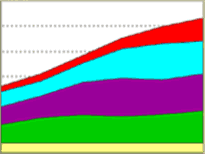
Chart of cancer statistics
An estimated 555,500 Americans are expected to die of cancer in 2002. While cancer affects people of all racial and ethnic groups, it does not affect all groups equally.
These inequities have been described as “health disparities.” A National Institutes of Health working group defined health disparities as “differences in the incidence, prevalence, mortality, and burden of cancer and related adverse health conditions that exist among specific population groups in the United States. These population groups may be characterized by gender, age, ethnicity, education, income, social class, disability, geographic location, sexual orientation.”
Statistics from the Annual Report to the Nation on the Status of Cancer 1973-1999 show that racial and ethnic minorities continue to suffer a higher cancer burden than whites and suggest that not all populations have benefited equally from cancer prevention and treatment control efforts.
For example, African-Americans experience the highest overall cancer incidence and mortality (death) rates compared other groups.
OVERALL INCIDENCE AND MORTALITY RATES
The following U.S. incidence and death rates are for all cancers combined.
- Cancer Incidence Rates (Number of new cases each year).
Statistics are for 1992-1999, are adjusted to the 2000 US standard million population, and represent the number of new cases of invasive cancer per year per 100,000 of both sexes, males, and females, respectively.
|
Group |
Both Sexes |
Males |
Females |
|
African-American |
526.6 |
703.6 |
404.8 |
|
White |
480.4 |
568.2 |
424.4 |
|
Asian/Pacific Islander |
348.6 |
408.9 |
306.5 |
|
Hispanic/Latino |
329.6 |
393.1 |
290.5 |
|
Amer Ind/Alaska Nat |
244.6 |
277.7 |
224.2 |
- Cancer Death Rates (Number of deaths each year).
Statistics are for 1992-1999, are adjusted to the 2000 US standard million population, and represent the number of deaths per year per 100,000 of both sexes, males, and females, respectively.
|
Group |
Both Sexes |
Males |
Females |
|
African-American |
267.3 |
369.0 |
204.5 |
|
White |
205.1 |
258.1 |
171.2 |
|
Asian/Pacific Islander |
128.6 |
160.6 |
104.4 |
|
Hispanic/Latino |
129.2 |
163.7 |
105.7 |
|
Amer Ind/Alaska Nat |
128.6 |
154.5 |
104.4 |
African-American women have the highest incidence rates for certain cancers, such as colon and rectal cancer and lung and bronchus cancer. African-American women also have the highest death rates for breast cancer. African-American men experience the highest incidence and death rates for a variety of cancers including lung and bronchus, prostate, and colon and rectum cancer.
While Hispanics/Latinos have lower incidence and death rates overall compared with those of African-Americans and whites, they do experience higher rates for certain cancers. Hispanic/Latina females have the highest incidence rates for cervical cancer and the second highest death rate from the disease. Hispanic/Latino men have the third highest incidence and death rates for prostate cancer.
Like the Hispanic/Latino population, Asian/Pacific Islanders experience lower incidence and mortality rates overall compared with other minority groups. However, they do experience higher death and incidence rates for certain cancers. For example, both men and women experience the highest incidence rates of liver and stomach cancer. Asian/Pacific Islander men, particularly, experience high death rates for liver and stomach cancer. Asian/Pacific Islander females have the third highest incidence rates for certain cancers such as breast, lung and bronchus, and colon and rectum cancer.
Lastly, while American Indian/Alaska Natives experience some of the lowest rates among all groups, they do experience higher death and incidence rates for certain cancers. For example, while the liver cancer incidence rate for American Indian/Alaska Natives is much lower than all other groups, American Indian/Alaska Natives, and Asian/Pacific Islanders are the only populations in which liver cancer is among the top 10 cancers sites. Additionally, American Indian/Alaska Native females have the third highest mortality rate for lung and bronchus cancer.
The reasons behind the disparities are varied, however many of the differences in cancer incidence and mortality rates among racial and ethnic groups may be due to factors associated with social class rather than ethnicity. Socioeconomic status (SES) in particular appears to play a major role in the differences in cancer incidence and mortality rates, risk factors, and screening prevalence among racial and ethnic minorities. Moreover, studies have found that SES, more than race, predicts the likelihood of a group’s access to education, certain occupations, and health insurance, as well as income level and living conditions, all of which are associated with a person’s chance of developing and surviving cancer.
The study of cancer health disparities has been designated as one of NCI’s key challenge areas. The National Cancer Institute is currently funding hundreds of research programs and studies related to understanding and eventually eliminating health disparities. A full listing of these programs can be found at: http://newscenter.cancer.gov/pressreleases/healthdisparities.html.
 NCI NewsCenter
NCI NewsCenter NCI Budget Data
NCI Budget Data Visuals Online
Visuals Online NCI Fact Sheets
NCI Fact Sheets Understanding Cancer Series
Understanding Cancer Series